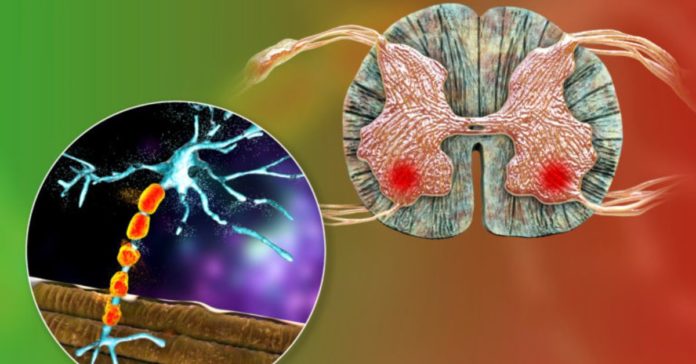Primary lateral sclerosis or PLS is a disease where the nerve cells in the brain that control movement, which is also called upper motor neurons, slowly break down and fail over time.
This prevents the nerves from activating the motor neurons present within the spinal cord controlling the muscles. Primary lateral sclerosis or PLS results in weakening of the voluntary muscles that are used to control the arms, tongue and legs.
.
What is primary lateral sclerosis?
When the central nerve cells are unable to activate the motor neurons in the spinal cord, which control voluntary muscles, it can cause movement problems like slowed movement and clumsiness, difficulty with balance, weakness and problems with swallowing and speech.
Primary lateral sclerosis is also known as progressive upper motor neuron dysfunction, in the absence of the clinical symbols of the lower motor neuron participation or family history suggestive of hereditary spastic paraplegia.
Primary lateral sclerosis is one of the sporadic motor neuron disorders, comprising progressive muscular atrophy (only lower motor neuron) and amyotrophic lateral sclerosis (mixed lower and upper motor neuron participation). It is a rare disorder with two types , one affecting adults and a juvenile form .
What are the symptoms of primary lateral sclerosis?
The signs and symptoms of primary lateral sclerosis are:
- Weakness and stiffness and spasms in the legs
- Slowing movement
- Tripping or problem in balancing because of the weakness in the leg muscles
- Weakness as well as stiffness in the arms, tongue, hands and also in the jaw sometimes
- Slowed speech, hoarseness and drooling
- Difficulty in swallowing breathing and bladder issues at a later stage in this disease
Signs and symptoms of primary lateral sclerosis generally take years to progress and usually begin in the legs.
Less frequently, primary lateral sclerosis starts in the hands and the tongue and after some time, it reaches the spinal cord and then the legs.
When do you need to see a doctor?
Consult your doctor if you are facing complications like stiffness or weakness in the legs or while speaking and swallowing. If your child is growing and facing spasticity in the voluntary muscles or is losing balance abnormally, then make an appointment with a pediatrician.
.
Call 1860-500-1066 to book an appointment.
What causes primary lateral sclerosis?
In PLS, the nerve cells that are present in the brain start failing with the passage of time. This loss results in movement complications, like slow movements, issues in balancing and bungling. The major cause of adult PLS is still not discovered. In the maximum number of cases, it is not a genetic disease.
Mutations in a gene called ALS2 causes juvenile PLS (primary lateral sclerosis). ALS2 gene gives instructions to create a protein called alsin, which is present in motor neuron cells. If alsin becomes unstable, it may in turn, impair normal muscle function. Juvenile PLS is an autosomal recessive inherited disease, which means that both the parents have to be the carriers of the gene to pass it on to their child, even though they themselves do not have the disease.
What are the treatment options for primary lateral sclerosis?
There is no treatment to prevent or stop primary lateral sclerosis. However, the treatment which focuses on providing relief from the symptoms and preserving functions consists of:
-Medications like baclofen, clonazepam, tizanidine, etc. to relieve the stiffness. You have to take these medications orally.
– If you are not able to control the stiffness issue with the oral medication, your doctor would’ve to perform a surgery for inserting a medication pump to supply baclofen to your spinal fluid.
-Some antidepressants may be presecribed if you are suffering from the problem.
-Physical therapy too helps in treating this disorder while stretching activities or exercises help in maintaining the strength of the muscle and providing uninterrupted mobility to the joints. Heating pads also relieve muscle pain.
-If the facial muscles are affected due to PLS, speech therapy is also an option to get relief.
– Physical therapists can also suggest some assistive devices like a cane, wheelchair, walker, etc.
Conclusion
Primary lateral sclerosis is not fatal in nature. However, there is no possible cure and the progression of the indications varies. Some people can preserve the ability to walk without any support or assistance, but others will ultimately need wheelchairs, walkers, canes, etc.
Frequently Asked Questions (FAQs)
How fast does primary lateral sclerosis develop?
It is more common in men with a gradual onset between the ages of 40 and 60. Primary lateral sclerosis develops progressively over a number of years or sometimes even decades.
Is primary lateral sclerosis a disability?
Unlike amyotrophic lateral sclerosis (ALS), the prognosis in primary lateral sclerosis is slower . However, primary lateral sclerosis is a progressive disorder.
Can primary lateral sclerosis start in the arms?
This disorder commonly starts in the legs but can begin in the upper body muscles as well.


















